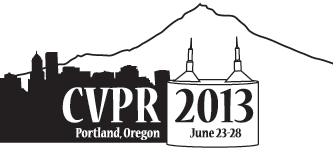-
Seeking the Strongest Rigid Detector
AbstractThe current state of the art solutions for object detection describe each class by a set of models trained on discovered sub-classes (so called "components"), with each model itself composed of collections of interrelated parts (deformable models). These detectors build upon the now classic Histogram of Oriented Gradients+linear SVM combo. In this paper we revisit some of the core assumptions in HOG+SVM and show that by properly designing the feature pooling, feature selection, preprocessing, and training methods, it is possible to reach top quality, at least for pedestrian detections, using a single rigid component. We provide experiments for a large design space, that give insights into the design of classifiers, as well as relevant information for practitioners. Our best detector is fully feed-forward, has a single unified architecture, uses only histograms of oriented gradients and colour information in monocular static images, and improves over 23 other methods on the INRIA, ETH and Caltech-USA datasets, reducing the average miss-rate over HOG+SVM by more than 30%.
Related Material
[pdf][bibtex]@InProceedings{Benenson_2013_CVPR,
author = {Benenson, Rodrigo and Mathias, Markus and Tuytelaars, Tinne and Van Gool, Luc},
title = {Seeking the Strongest Rigid Detector},
booktitle = {Proceedings of the IEEE Conference on Computer Vision and Pattern Recognition (CVPR)},
month = {June},
year = {2013}
}
These CVPR 2013 papers are the Open Access versions, provided by the Computer Vision Foundation.
Except for the watermark, they are identical to the accepted versions; the final published version of the proceedings is available on IEEE Xplore.
Except for the watermark, they are identical to the accepted versions; the final published version of the proceedings is available on IEEE Xplore.
This material is presented to ensure timely dissemination of scholarly and technical work.
Copyright and all rights therein are retained by authors or by other copyright holders.
All persons copying this information are expected to adhere to the terms and constraints invoked by each author's copyright.

